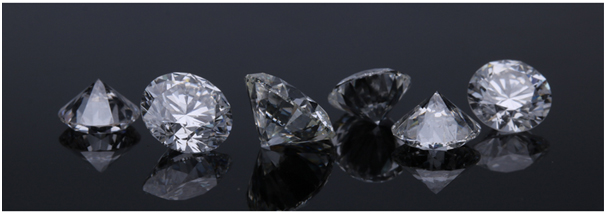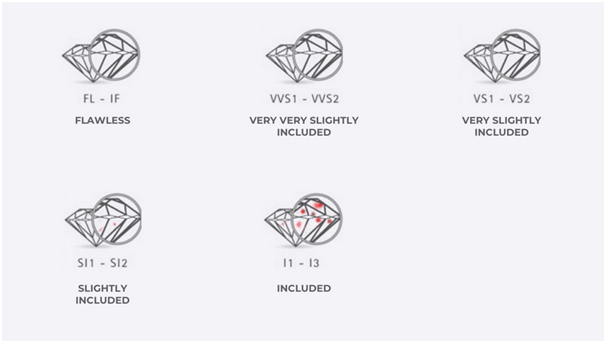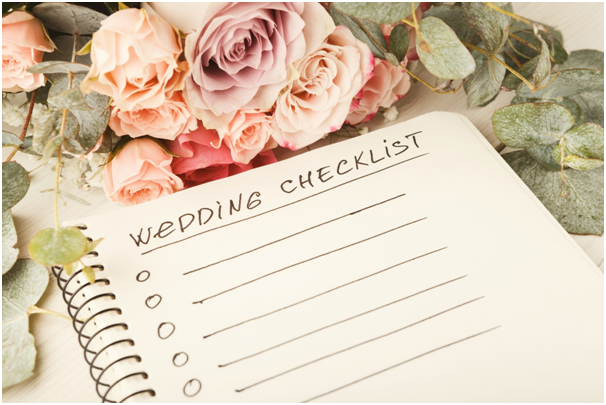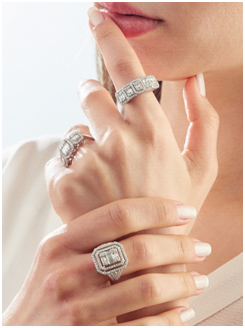The Ultimate Guide to the Clarity of Diamonds
When it comes to choosing the perfect diamond engagement ring, there are a lot of factors to consider. After all, there is a certain science behind the perfect sparkle! Before purchasing, it’s important to think about ‘the four Cs’: cut, colour, clarity, and carat weight. They offer all the information you need to choose the right diamond for you at the best price. Wrapping your head around the four Cs will help you to feel confident about your purchase.

Today, we’re zooming in one of the Cs – clarity. Diamond clarity is an extremely important consideration when you’re searching for a new piece of diamond jewellery. Read on to learn more about what we mean when we say ‘clarity’ and how to put clarity knowledge to good use when purchasing diamonds.
What is diamond clarity?
Diamond clarity is defined by the number of inclusions or blemishes present in the stone. For example, a diamond with a high clarity rating will be free of visible inclusions and look flawless.
To understand more about how clarity is ranked, we must first consider the process in which diamonds are formed. These gemstones are created naturally when carbon is put under a great amount of pressure and heat. As you can imagine, this process is intense and can lead to certain internal marks (inclusions) and external marks (blemishes). Specifically, tiny crystals often get trapped within a diamond while it is still forming, and these crystals can grow to form an inclusion.
Often, diamond inclusions aren’t visible to the naked eye. When assessing a diamond through a magnifying jeweller's loupe, however, blemishes can be seen. The fewer inclusions in a diamond, the higher the clarity rating the diamond receives. This rating will impact the value of the diamond, with flawless specimens naturally chasing a far larger sum.
You shouldn’t be put off by a few inclusions, though. After all, no diamond is 100 per cent pure. Even so, it is useful to understand the diamond clarity chart and know what you’re looking for. This way, you won't end up paying too much for a diamond with a low clarity rating.
What diamond clarity is best?
To find out how a diamond scores in terms of clarity, consult the diamond clarity chart created by the Gemological Institute of America (GIA). The scale is divided into 11 specific clarity grades ranging from FL (flawless) to I3 (obvious inclusions). According to the official grading defined by the GIA, the different types of diamond clarity are:

- Flawless (FL): No inclusions and no blemishes visible under 10x magnification
- Internally Flawless (IF): No inclusions visible under 10x magnification
- Very, Very Slightly Included (VVS1 and VVS2): Inclusions so slight they are difficult for a skilled grader to see under 10x magnification
- Very Slightly Included (VS1 and VS2): Inclusions are observed with effort under 10x magnification but can be characterised as minor
- Slightly Included (SI1 and SI2): Inclusions are noticeable under 10x magnification
- Included (I1, I2, and I3): Inclusions are obvious under 10x magnification which may affect transparency and brilliance
Thanks to the GIA clarity scale, we now have a universal way of assessing clarity, rather than simply describing the appearance of each stone. This allows us to value diamonds correctly, and it gives a clear indication of the quality of the diamond you’re considering purchasing.
How to know diamond clarity?
When you’re shopping for a diamond ring online, the retailer should declare the clarity of the diamond. If they don’t provide this, don’t go ahead with the purchase. As well as declaring the clarity, all diamond jewellery retailers should also supply an independent diamond certificate and a detailed valuation certificate with your purchase. These both prove that the clarity of the diamond has been independently confirmed, along with the rest of the four Cs.
Does diamond clarity really matter?
If you want to make sure that you’re getting your money’s worth when purchasing a diamond, clarity certainly matters – particularly if you’re buying a diamond as an investment piece. In addition to this, the clarity of the diamond has an impact on its appearance, which is of course important when you’re considering a diamond engagement ring or wedding ring. Diamonds with a higher clarity will sparkly more brightly in the light. However, no two diamonds are the same, and blemishes can also give a diamond character and uniqueness. Ultimately, it all depends on what you’re looking for in a diamond and what your budget is.
Now that you’re informed on clarity and know exactly what you’re looking for, you’ll be able to shop online for diamonds with confidence! Just remember to always consider the four Cs and check for those all-important diamond certificates.
You May Also Like

The Ultimate Guide to Planning Your Big Day
The proposal is done, and now it’s time to start planning your b ...

The Best Romance Movies for Every Occasion
Sometimes, there is nothing we need more than to cosy up in front of t ...

Our Top Tips for How to Style Your Wedding Ring
Congratulations, you’re engaged! You’re completely in love ...
